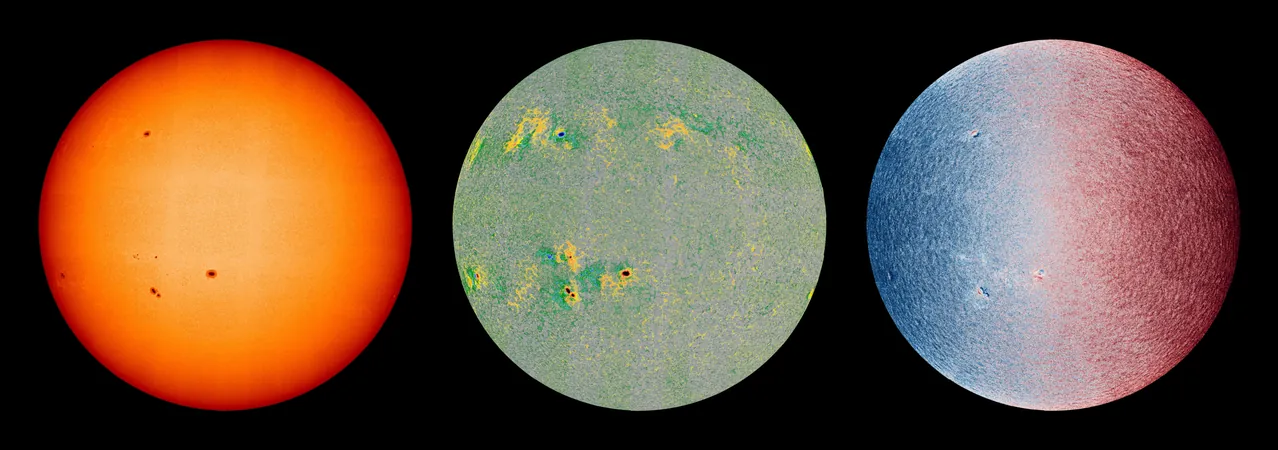
Stunning New Sun Images Unveil Intricate Details of Sunspots and Plasma Dynamics
2024-11-21
Author: Wei
Stunning New Sun Images Unveil Intricate Details of Sunspots and Plasma Dynamics
In a groundbreaking revelation, the European Space Agency (ESA)-led Solar Orbiter mission has delivered the most detailed images of the Sun's surface to date, showcasing its dynamic and multifaceted nature. Utilizing six sophisticated imaging instruments, the Solar Orbiter promises to transform our understanding of our closest star.
These high-resolution images, captured by the Polarimetric and Helioseismic Imager (PHI), allow scientists to observe the Sun's visible surface, known as the photosphere, with unprecedented clarity. PHI not only collects images in visible light but also measures the magnetic fields and the speed of surface movement. This dual capability enables researchers to create a comprehensive map of the Sun's magnetic architecture, essential for understanding the processes that drive solar activity.
In conjunction with PHI, the Extreme Ultraviolet Imager (EUI) provided simultaneous high-resolution images of the Sun’s outer atmosphere, or corona. This innovative approach helps researchers link the magnetic field behaviors observed on the photosphere to phenomena occurring in the corona, emphasizing the significance of the Sun's magnetic dynamics.
Daniel Müller, the project scientist for the Solar Orbiter, highlighted the importance of these findings, stating, "The Sun's magnetic field is crucial for understanding our star's dynamic nature at all scales. These new high-resolution maps unveil the Sun’s surface magnetic field and flows, providing critical data to deduce the magnetic structure of the Sun's corona."
Exploring Sunspots and Plasma Movement
The latest images reveal sunspots, which appear as dark blemishes on the Sun's otherwise bright surface. These spots are cooler regions resulting from intense magnetic activity. The surrounding hot plasma—at temperatures ranging from 4500 to 6000 °C—exhibits a restless, grainy texture reminiscent of bubbling magma beneath the Earth's surface. The high-resolution images illustrate how the convection of this plasma plays a crucial role in the Sun's behavior.
Notably, the magnetogram captured by PHI indicates concentrated areas of the Sun's magnetic field in sunspot regions, with red indicating outward magnetic forces and blue depicting inward forces. This concentration of magnetic energy directly correlates with the cooler temperatures observed in sunspots, as strong magnetic fields inhibit the usual convection currents.
In an additional insight, PHI's velocity map, or tachogram, allows researchers to visualize the movement of material on the Sun's surface. The dynamic plasma generally rotates in synchrony with the Sun's spin, yet it displays outward movement in the vicinity of sunspots, showcasing the complex fluid dynamics at play.
Revelatory Insights into the Sun’s Corona
The EUI's images of the corona, which extends millions of kilometers into space, reveal glowing streams of plasma caused by solar magnetic fields that connect adjacent sunspot regions. These bright structures can reach temperatures of up to one million degrees Celsius, illustrating the high-energy environment above the Sun's surface.
The Art of Image Stacking
To create a complete view of the Sun, Solar Orbiter captured multiple images during its close approach—within 74 million kilometers of the Sun—over a timeframe of more than four hours. The result is a stunning mosaic composed of 25 images each from PHI and EUI, which together provide an extensive high-resolution view of the solar disk.
The development of these complex mosaics required innovative image processing techniques. The successful creation of the PHI mosaics heralds the potential for more efficient future data assembly, with expectations of releasing similar high-resolution mosaics twice a year, allowing an even deeper exploration of our nearest star.
In summary, the insights gained from these pioneering images not only highlight the intricate details of sunspots and plasma dynamics but also unlock possibilities for a deeper understanding of solar phenomena that impact space weather, potentially affecting our technological systems on Earth. Stay tuned for more revelations as the Solar Orbiter continues its celestial journey!

 Brasil (PT)
Brasil (PT)
 Canada (EN)
Canada (EN)
 Chile (ES)
Chile (ES)
 España (ES)
España (ES)
 France (FR)
France (FR)
 Hong Kong (EN)
Hong Kong (EN)
 Italia (IT)
Italia (IT)
 日本 (JA)
日本 (JA)
 Magyarország (HU)
Magyarország (HU)
 Norge (NO)
Norge (NO)
 Polska (PL)
Polska (PL)
 Schweiz (DE)
Schweiz (DE)
 Singapore (EN)
Singapore (EN)
 Sverige (SV)
Sverige (SV)
 Suomi (FI)
Suomi (FI)
 Türkiye (TR)
Türkiye (TR)